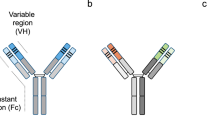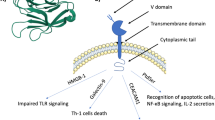Abstract
In a pilot clinical study carcinoma patients with malignant ascites or pleural exudates have been treated locally with autologous lymphocytes activated ex vivo and redirected towards tumour cells with bispecific monoclonal antibodies. BIS-1, the bispecific monoclonal antibody used in this study, combines specificity against a tumour-associated antigen, AMOC-31, present on carcinomas, with a specificity against the CD3 complex on T lymphocytes. Patients selected for treatment had malignant pleural or peritoneal effusions. Treatment consisted of isolating autologous peripheral blood lymphocytes, ex vivo activation, incubation with bispecific monoclonal antibodies and injection at the effusion site of these BIS-1-redirected lymphocytes. To evaluate the effects of the bispecific monoclonal antibody, five patients received treatments with activated lymphocytes without bispecific antibodies. Effusion samples taken before and at various times after treatment were analysed by immunocytology and for the presence of the soluble factors carcinoembryonic antigen (CEA), interleukin-6 (IL-6), tumour necrosis factor (TNF), C-reactive protein and soluble CD8. In this way both immune activation and anti-tumour activity could be monitored. Conjugate formation between tumour cells and activated lymphocytes was seen as soon as 4 h after injection of BIS-1-redirected activated lymphocytes, followed by a disappearance or reduction of tumour cells after 24–48 h. In parallel with this, the soluble tumour marker CEA decreased in the effusion fluid following injection with the BIS-1-redirected lymphocytes. Furthermore, a steep increase in local granulocyte numbers was observed in the effusion fluid, which reached a maximum 24–48 h after the start of the treatment. Also levels of IL-6 and TNF were greatly elevated. The data suggest tha the treatment induces both antitumour activity and a strong local inflammatory reaction. This is accompanied by no or only minor local and systemic toxicity, i.e. mild fever, which disappeared as the local inflammatory reaction diminished 48–72 h after treatment.
Similar content being viewed by others
References
Appelgate KG, Balch CM, Pellis NR (1990) in vitro migration of lymphocytes through collagen matrix: arrested locomotion in tumorinfiltrating lymphocytes. Cancer Res 50: 7153
Bolhuis RLH, Sturm E, Braakman E (1991) T cell targeting in cancer therapy. Cancer Immunol Imunother 34: 1
Blakely DC, Thorpe PE (1988) An overview of therapy with immunotoxins containing ricin or its A-chain. Antibody Immunocon Radiopharmacol 1: 1
Braakman E, Goedegebuure PS, Vreugdenhil RJ, Segal DM, Shaw S, Bolhuis RLH (1990) ICAM-1-melanoma cells are relatively resistant to CD3-mediated T-cell lysis. Int J Cancer 46: 475
Brissinck J, Demanet C, Moser M, Leo O, Thielemans K (1991) Treatment of mice bearing BCL lymphoma with bispecific antibodies. J Immunol 147: 4019
Ferrini S, Prigione I, Miotti S, Ciccone E, Cantoni C, Chen Q, Colnaghi MI, Moretta L (1991) Bispecific monoclonal antibodies to CD and to a tumor associated antigen induce target-cell lysis by resting NK cells and by a subset of NK clones. Int J Cancer 48: 227
Garrido MA, Valdayo MJ, Winkler DF, Titus JA, Hecht TT, Perez P, Segal DM, Wunderlich JR (1990) Refocussing the immune system to react with human tumors by targeting human lymphocytes with bispecific antibodies. Dev Biol Stand 71: 33
Garrido MA, Perez P, Titus JA, Valdayo MJ, Winkler DF, Barbieri SA, Wunderlich JR, Segal DM (1990) Targeted cytotoxic cells in human peripheral blood lymphocytes. J Immunol 144: 2891
Helle M, Boeye L, Groot E de, Vos A de, Aarden L (1991) Sensitive ELISA for I-6; detection of IL-6 in biological fluids, synovial fluids and sera. J Immunol Methods 138: 47
Herlyn M, Steplewski Z, Herlyn D, Koprowski H (1979) Colorectal carcinoma-specific antigen: detection by means of monoclonal antibodies. Proc Natl Acad Sci USA 75: 1438
Kerr L, Huntoon C, Donohue J, Leibson PJ, Bander NH, Ghose T, Luner SJ, Vessella R, McKean DJ (1990) Hetero conjugate antibodydirected killing of autologous human renal carcinoma cells by in vitro-activated lymphocytes. J Immunol 144: 4060
Lau WBM de van Loon AE, Heije K, Valerio D, Bast EJEG (1989) production of hybrid hybridomas based on HATs-neomycinr double mutants. J Immunol Methods 117: 1
Leij L de, Postmus PE, Poppema S, Elema JE, The TH (1986) The use of monoclonal antibodies for the pathological diagnosis of lungcancer. In: Hansen HH (ed) Lung cancer: basic and clinical aspects. Nijhof, The Hague, p 31
Mackay CR, Marston WL, Dudler L, Spertini O, Tedder TF, Hein WR (1992) Tissue specific migration pathways by phenotipically distinct subpopulations of memory T cells. Eur J Immunol 22: 887
Makgoba MW, Sanders ME, Shaw S (1989) The CD2-LFA3 and LFA1-ICAM pathways: relevance to T-cell recognition. Immunol Today 10: 417
Mezzanzanica D, Canevari S, Colnaghi MI (1991) Retargeting of human lymphocytes against human ovarian carcinoma cells by bispecific antibodies: from laboratory to clinic. Int J Clin Lab Res 21: 159
Mezzanzanica D, Garido MA, Neblock DS, Daddona PE, Andrew SM, Zurawski VR, Segal DM, Wunderlich JR (1991) Human T-lymphocytes targeted against an established human ovarian carcinoma with a bispecific F(ab')2 antibody prolong host survival in a murine xenograft model. Cancer Res 51: 57
Milstein C, Cuello AC (1984) Hybrid hybridomas and the production of bi-specific monoclonal antibodies. Immunol Today 5: 299
Nishimura T, Nakamura Y, Tsulamoto H, Takeuchi Y, Tokuda Y, Iwasawa M, Yamamoto T, Masuko T, Hashimoto Y, Habu S (1992) Humanc-erbB-2 proto-ongogene product as a target for bispecificantibody directed adoptive tumor immunotherapy. Int J Cancer 50: 800
Nitta T, Sato K, Okumura K, Ishii S (1990) Induction of cytotoxicity in human T cells coated with anti-glioma X anti-CD3 bispecific antibody against human glioma cells. J Neurosurg 72: 476
Nitta T, Sato K, Yagita H, Okumura K, Ishii S (1990) Preliminary trial of specific targeting therapy against malignant glioma. Lancet 335: 368
Perez P, Titus JA, Lotze MT, Cuttitta F, Longo DL, Groves ES, Rabin H, Durda PJ, Segal DM (1986) Specific lysis of human tumor cells by T cells coated with anti-T3 cross-linked to anti-tumor antibody. J Immunol 137: 2069
Rivoltini L, Cattoretti G, Arienti F, Mastroianni A, Melani C, Colombo MP, Parmiani G (1991) The high lysability by LAK cells of colon-carcinoma cells resistant to doxorubicin is associated with a high expression of ICAM-1, LFA-3, NCA and a less differentiated phenotype. Int J Cancer 47: 746
Roosnek EE, Lier RA van, Aarden LA (1987) Two monoclonal anti-CD3 antibodies can induce different events in human T lymphocyte activation. Eur J Immunol 17: 1507
Rosenberg SA, Lotze MT, Muul LM (1987) A progess reprot on the treatment of 157 patients with advanced cancer using lymphokine activated killer cells and IL-2 or high dose IL-2 alone. N Engl J Med 316: 889
Rosenberg SA, Schwarz SL, Spiess PJ (1988) Combination immunotherapy for cancer: synergistic anti tumour interactions of interleukin-2, alfa interferon and tumour infiltrating lymphocytes. J Natl Cancer Inst 80: 139
Ségal DM, Qian JH, Andrew SM, Titus JA, Mezzanzanica D, Garrido MA, Wunderlich JR (1991) Cytokine release by peripheral blood lymphocytes targeted with bispecific antibodies, and its role in blocking tumor growth. Ann NY Acad Sci 636: 228
Shaw S, Luce GEG, Quinones R, Gress RE, Springer TA, Sanders ME (1986) Two antigen-independent adhesion pathways used by human cytotoxic T-cell clones. Nature 323: 262
Shimizu Y, Newman W, Tanaka Y, Shaw S (1992) Lymphocyte interactions with endothelial cells. Immunol Today 13: 106
Spits H, Schoten W, Keizer H, Seventer G van, Rijn M van de, Terhorst D, Vries JE de (1986) Alloantigen recognition is preceded by non specific adhesion of cytotoxic T cells and target cells. Science 232: 403
Spronk PE, Borg EJ ter, Limburg PC, Kallenberg CGM (1992) Plasma concentration of IL-6 in systemic lupus erythematosus; an indicator of disease activity. Clin Exp Immunol 90: 106
Spurr NK, Durbin H, Sheer D, Parkar M, Bobrow L, Bodmer WF (1986) Characterization and chromosomal assignment of a human cell surface antigen defined by the monoclonal antibody AUA-I. Int J Cancer 38: 631
Stearz UD, Bevan MJ (1986) Hybrid hybridoma producing a bispecific monoclonal antibody that can focus effector T-cell activity. Proc Natl Acad Sci USA 83: 1453
Stearz UD, Kanagawa O, Bevan MJ (1985) Hybrid antibodies can target sites for attack by T cells. Nature 31: 628
Stötter H, Wiebke EA, Tomita A, Belldegrun A, Topilian S, Rosenberg SA, Lotze MT (1989) Cytokines alter target cell suseptibility to lysis. J Immunol 142: 1767
Tax WJM, Reekers HW, Reekers PPM, Capel PJA, Koene RH (1983) Polymorphism in mitogenic effect of IgG monoclonal antibodies against T3 antigen on human T-cell. Nature 304: 445
Tomita Y, Nishiyama T, Watanabe H, Fujiwara M, Sato S (1990) Expression of intercellular adhesion molecule-I (ICAM-1) on renal-cell cancer: possible significance in host immune responses. Int J Cancer 46: 1001
Tomkinson BE, Brown MC, IP SH, Carabis S, Sullivan JL (1989) Soluble CD8 during T cell activation. J Immunol 142: 2230
Wauwe JP van, Mey JR de, Goosens JG (1980) OKT3: a monoclonal anti-human T-lymphocyte antibody with potent mitogenic properties. J Immunol 124: 2708
Weiner GJ, Hillstrom JR (1991) Bispecific anti-idiotype/anti-CD3 antibody therapy of murine B cell lymphoma. J Immunol 147: 4035
West WH, Tauer KW, Yannelli JR, Marshall GD, Orr DW, Thurman GB, Oldhan RK (1987) Constant infusion interleukin 2 in adoptive immunotherapy of advanced cancer. N Engl J Med 3: 898
Woo DV, Li D, Steplewski Z (1989) Selective chromosomal damage and cytotoxicity of 125-I-labeled monoclonal antibody 17-1A in human cancer cells. Cancer Res 49: 2952
Author information
Authors and Affiliations
Rights and permissions
About this article
Cite this article
Kroesen, B.J., ter Haar, A., Spakman, H. et al. Local antitumour treatment in carcinoma patients with bispecific-monoclonal-antibody-redirected T cells. Cancer Immunol Immunother 37, 400–407 (1993). https://doi.org/10.1007/BF01526797
Received:
Accepted:
Issue Date:
DOI: https://doi.org/10.1007/BF01526797




